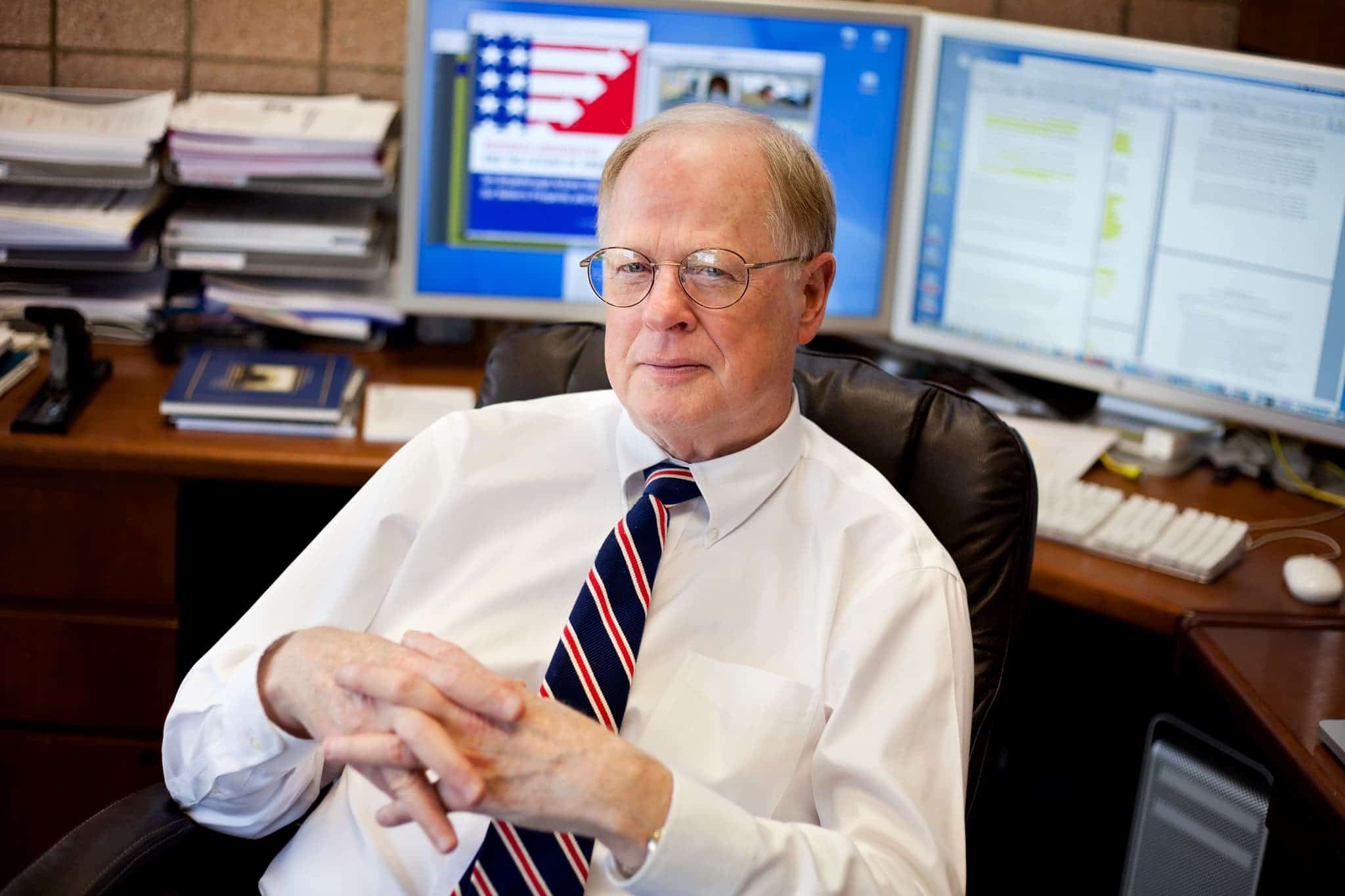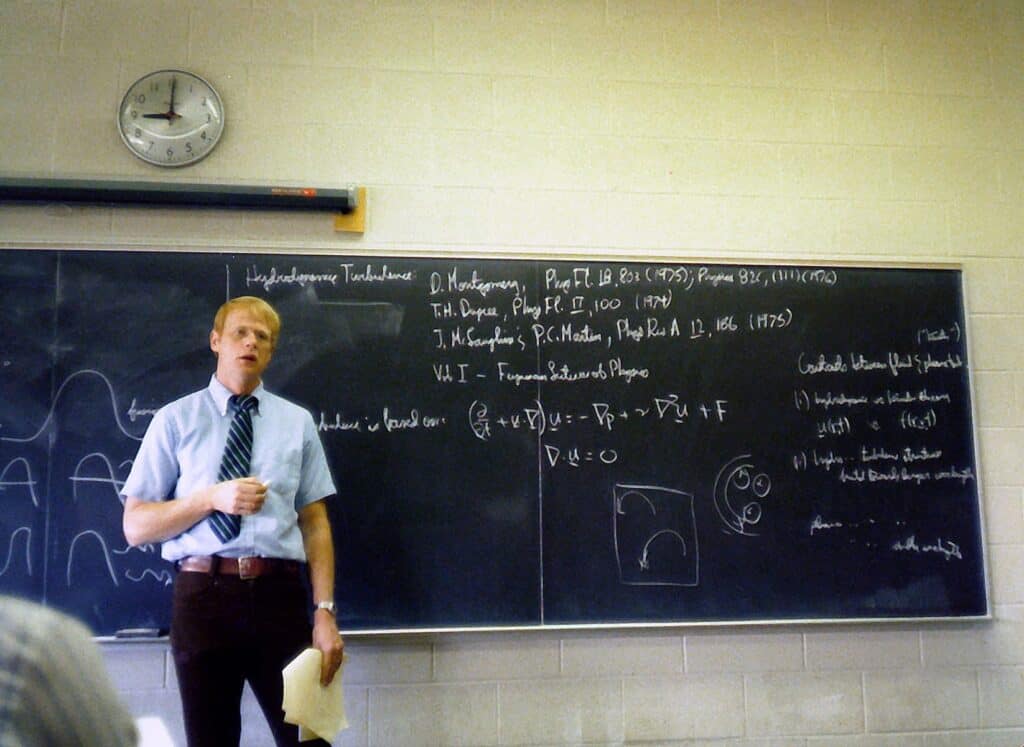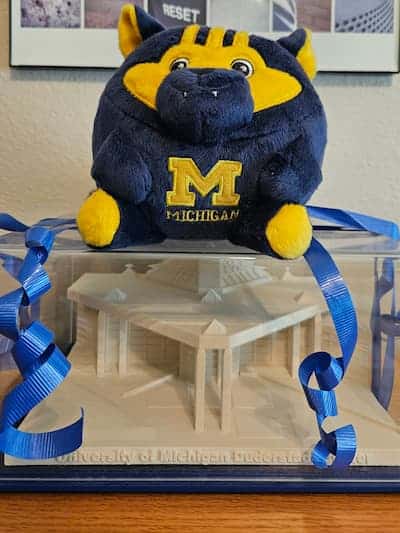
James Duderstadt’s impact on NERS
Duderstadt helped shape the department into a powerhouse of computational methods development for neutron transport and reactor physics research.

Duderstadt helped shape the department into a powerhouse of computational methods development for neutron transport and reactor physics research.
The University of Michigan Nuclear Engineering & Radiological Sciences (NERS) department and the broader academic and scientific communities mourn the loss of Dr. James J. Duderstadt, President Emeritus and University Professor of Science and Engineering, who passed away on August 21, 2024.
Professor Duderstadt’s remarkable career spanned over five decades, during which he left an indelible mark on the fields of engineering, higher education, and public policy. While he is widely recognized for his contributions to Michigan Engineering, the University, and the nuclear community at large, his impact on the hearts, minds, and theses of those who knew him within NERS is immeasurable.
Hired in 1968, Duderstadt brought a new level of recognition to the department, particularly in the realm of computational transport and reactor analysis. Along with his colleague Louis Hamilton, he laid the groundwork for the department’s subsequent rise as a leader in these fields.
In the early 1970s, Duderstadt and Hamilton co-authored Nuclear Reactor Analysis, a textbook that quickly became the leading reference in the field. The book’s lasting influence on nuclear engineering education continues to be felt today. Duderstadt’s scholarly work extended further with the publication of Transport Theory in 1979, co-authored with William Martin.

Duderstadt’s engagement with nuclear reactor analysis was not confined to textbooks. He played a crucial role in research that pushed the boundaries of nuclear technology, including his involvement in the early days of laser-driven fusion. During a summer at the Lawrence Livermore National Laboratory, he became deeply involved in this cutting-edge technology.
As Duderstadt’s career progressed, he became increasingly involved in shaping the future of the department and the College of Engineering as a whole. His rise to the role of Dean of Engineering in 1981 marked a turning point for the College, particularly in terms of faculty compensation and strategic planning. His pivotal role in the North Campus move was critical to consolidating the engineering programs and enhancing the overall research environment. His leadership extended beyond the College when he was appointed Provost and Vice President for Academic Affairs. Just two years later, he was elected President of the University. During his presidency, he led the University through significant transformations, enhancing its reputation as a global leader in education and research.
Although deeply dedicated to his administrative obligations, Duderstadt remained actively involved in the department’s curriculum development, introducing new courses such as NERS 190: Special Topics in Nuclear Engineering and Radiological Sciences. Even after finishing his term as President in 2003, Duderstadt continued to engage with students and faculty, teaching courses like Technology Challenges for the 21st Century.
After his time as president, Duderstadt continued to champion the department’s interests through his various external endeavors. He dedicated his time and effort to hold positions that supported NERS as well as our field. These included serving on the Nuclear Energy Advisory Committee of the Department of Energy and chairing the Board of Directors of the U.S. Department of Energy’s Consortium for Advanced Simulation of Light Water Reactors Nuclear Energy Innovation Hub.
Throughout his career, Duderstadt received numerous accolades, reflecting his status as a leader in the field. He was a Fellow of the American Nuclear Society (ANS) and the American Association for the Advancement of Science (AAAS), a member of the National Academy of Engineering, and a recipient of prestigious awards such as the National Medal of Technology, the E.O. Lawrence, and the Vannevar Bush Award. His contributions to nuclear science and engineering were recognized not only by his peers but also by national and international bodies.
James Duderstadt’s legacy at NERS is one of innovation, leadership, and enduring impact. His work helped shape the department into a powerhouse of computational methods development for neutron transport and reactor physics, securing its place at the forefront of nuclear engineering education and research. His vision and dedication continue to inspire generations of engineers and scientists.
(Please send your submission to [email protected].)
“I first met Jim as a first-year graduate student in NE 441 and later as my thesis advisor. He was a patient and effective advisor who became a friend, running partner, and colleague. Jim’s contributions to our department, our college, our university, our profession, and our country, were profound. He was an exceptional scientist, author, and academic administrator, but most of all, an exceptional person. I will miss him.” —William Martin, NERS Professor Emeritus
“On top of an already amazing career, Jim spent the later years of his career acting as a historian for the Department, for the College, and for the University broadly. He impressed upon me the importance of respecting your history and building off of those strengths. This profound strength as a storyteller of excellence helped me improve my approach to leadership and I will always be thankful for that mentorship.” —Todd Allen, NERS Chair
“It is so sad news to lose such an incredible colleague as Jim. His contributions to the department, the college, and the university are simply enormous. Jim was one of those individuals who was always thinking and engaging – never slowing down. He was so prolific – I wouldn’t be surprised if he turned out better than one book per year over his illustrious career. But beyond these impacts, he was a real friend and confidant, always seeking input and comment on his various projects, his view of the future, and that of his colleagues. He cared so much about the people in his life. I will miss the coffees we would have semi-regularly, over which we talked about whatever was on our minds.” Gary Was, NERS Professor Emeritus
“I had an opportunity to get together with Jim Duderstadt in late June and it is so sad and difficult for me to hear of his passing so soon. The whole nuclear engineering discipline owes him a debt of gratitude for his seminal contributions to the field, with his book Nuclear Reactor Analysis still serving as the reference for nuclear engineering, while the University of Michigan community has benefited immensely from his distinguished sustained leadership. I thank him for his help and support for me personally as a mentor, colleague, and friend over the past 50 years. I will miss JJD greatly.” —John Lee, NERS Professor Emeritus
“Prof. Duderstadt was a luminary whose accomplishments will be heralded for years to come. I knew him as my professor, my colleague, my dean, and my president. He was beloved in all of these roles, probably because he loved NERS, CoE, and U-M like no other. When he was solicited by other organizations, he declined by noting that his genes were blue and gold. He was a tireless visionary whose ideas inspired all of who knew him. We have lost a hero.” —David Wehe, NERS Professor
“Jim was a legend to me before I ever joined NERS (although it was not called that at the time), and when I met him soon after joining the department he was already president. We should remember his service as Chair of the National Science Board, in which role he ensured that federal government support for advanced manufacturing research expanded greatly. The College of Engineering, but more importantly the nation, benefited greatly from this. Jim was also a visionary in seeking to integrate engineering and the arts and media, resulting in the building that bears his name and laying the foundation for the strong integration of North Campus as a campus of creativity. Jim was a pioneer in recognizing the importance of information processing and communications systems in education and research, the foundation of what we today call the Information Age. This understanding led him, along with then Associate Dean Dan Atkins, to found CAEN (the Computer Aided Engineering Network) in 1983 when he was dean. At the time the idea of a few hundred locally networked computer workstations to support teaching and learning was innovative. Jim was also a deep thinker regarding higher education and his writings have influenced and challenged academic leadership around the country, certainly including my own. I will finally note his prescience regarding the role and nature of collegiate athletics, which he sought, with little success, to move in a different direction despite the professional harm that it caused him.” —James Holloway, NERS Professor Emeritus
“I met Jim on a few occasions. Most recently, he wanted to meet with the new faculty in the department to get to know them and just generally see if he could be of help. I also got to see him give at least two of the “history of the department” colloquia some years ago and attend the surprise celebration the department gave him to recognize his 50 years of service to the University. I was also fortunate enough to get him to autograph my copy of his textbook at the Michigan Memorial Phoenix Project rededication. He wrote “Hope you understand all of this. I’ve forgotten.” I contemplate this inscription from time to time, and now in my young career, I would say I know a great deal of that book, but probably not all of it. It’s something I still aspire to. While I think Jim jests about his age with forgetting, I would say that he forgot reactor analysis is more a testament to Jim that he basically went on to have an almost entirely separate career after teaching nuclear reactor analysis. It’s both humbling and inspiring to think of the accomplishments of a person like Jim where he was able to make a generational contribution to our field early enough that he was then still able to go on and have a second career of leadership and service to the university at the highest levels. Really, really a remarkable person who will be missed, but impossible to forget.” —Brendan Kochunas, Assistant Professor
“I am very sorry to hear of Professor Duderstadt’s passing. I was quite fortunate to take his public policy course in Winter 2019 during what I think may have been his last Michigan Engineering course. It was great hearing from such an accomplished Professor and always fun hearing him brag about his long list of books and publications in our discussion sections (I have a signed copy of one 🙂 ). He hosted an excellent course and to me, it seems his legacy for U-M and NERS during his distinguished career cannot be overstated.” —Flynn Darby, NERS Graduate Student

“I was one of the fortunate people that was touched by him and his wife’s generosity and kindness. I was Access Services Manager at the then Media Union before it became the Duderstadt Center. Every morning, like clockwork, Dr. Duderstadt came in the back entrance and passed the Info desk and always exchanged a greeting. His retirement gift to me was a replica in 3D of the front entrance to the ‘Dude’, and he affectionately called it: ‘The Verena Entrance’. I still treasure this gift, as well as the many autographed books that I received as Christmas gifts later on. A true Gentleman that I was honored to know and admire. May his vision and leadership continue in Heaven.” —Verena Ward, U-M Library, 1965–2009
“In late April 1974, I stovepiped through three feet of snow for over a mile to take my final exam in Jim Duderstadt’s class on Nuclear Reactor Analysis. It was my first year as a grad student. I arrived 20 minutes late, and Jim handed me my exam with a gentle smile. He was a brilliant teacher, a potent life coach, a pinpoint of red hair always moving through the hallways, dropping in unannounced, a fast-rising star who influenced the lives of so many, and all this—with that same gentle smile. I will miss his always positive view, even in times of stress. I will miss his clear insight and ability to lead you to many valuable personal connections. And I will miss dropping in on him unannounced, knowing he would drop his work, turn, and give me his full attention. He was one of several gifted professors in the U-M Nuclear Engineering Dept. back in the early 1970s, who rebuilt their graduate students into deeply curious, questioning, joyful, leaders in our fields.” —Paul Rockett, PhD 1977 in Nuclear Science
“James Duderstadt’s middle name is ACTION. As a Fuels Research Scientist with Atlantic Richfield Company in 1982, I called Jim in his role as Dean of Engineering to tell him about a college student/research technician in my fuels lab whose lab practices and processes were impeccable. Later that day the Chair of the School of Chemical Engineering called my assistant to invite him to Ann Arbor to explore graduate opportunities. Jim was always a tutor in process engineering and feedback from physical systems such as nuclear reactors. He so inspired me to write a CRC book ‘’Project Management Lessons Learned.’’ His influence in my life continues today as I publish a blog ‘’Mel Bost PMO Expert.’’ —Mel Bost, MS Nuclear Science 1971, MBA Ross Business School 1978